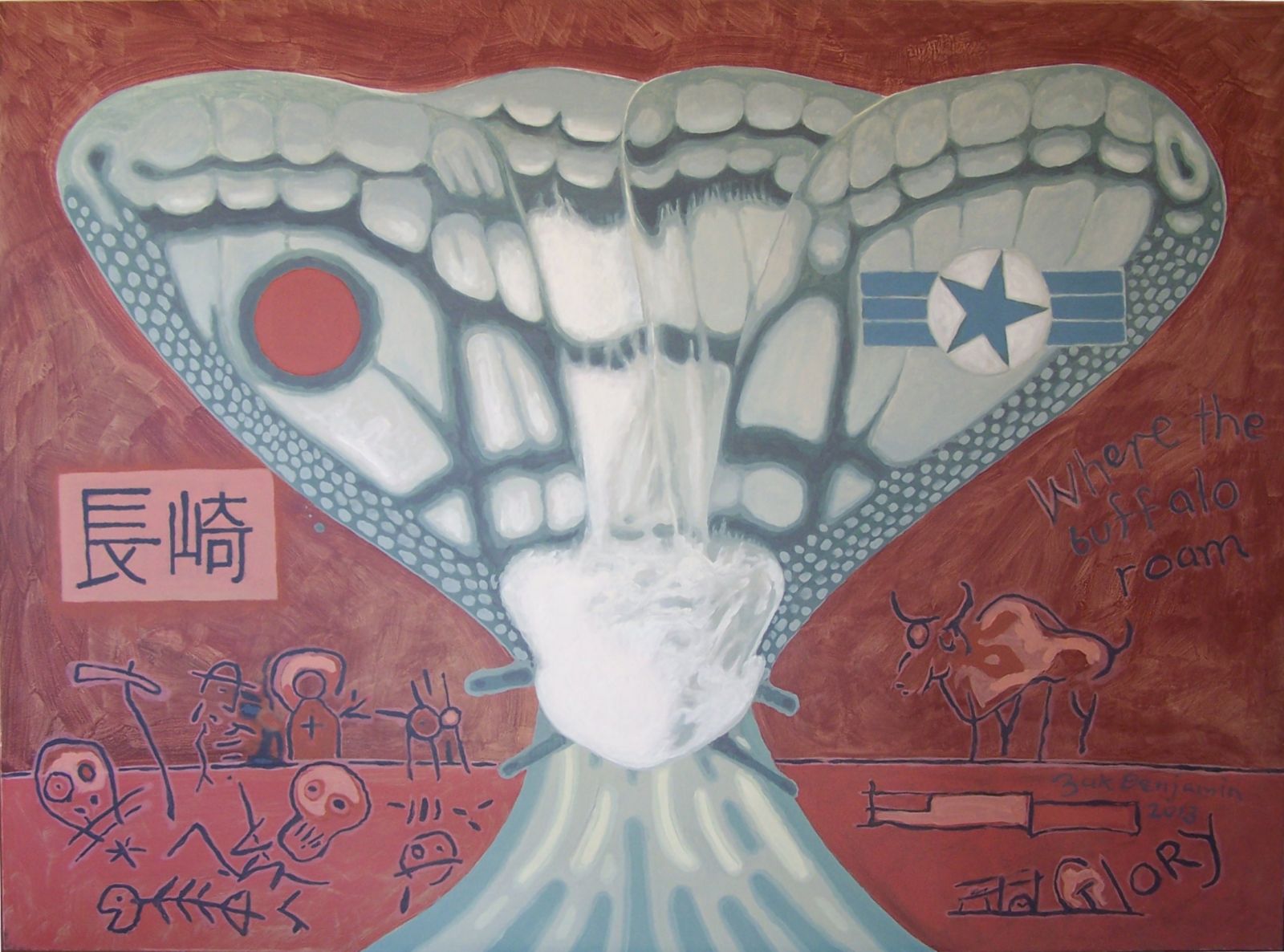Benjamin, Zak - VM - Erna Buber-deVilliers
Zak Benjamin: Nagasaki

Moths
by Erna Buber-deVilliers
This painting was inspired by a book, Song for Nagasaki. It tells the story of Takashi Nagai, whose wife was a victim of the atom bomb. Nagai died later of radiation sickness, contracted during his pioneering work as a radiologist.
In the painting the wings of a moth become the mushroom cloud of the atomic explosion. “Fat Man” – the bomb – was ‘accidentally’ dropped on Nagasaki. Bad weather prevented the pilot from finding the intended target, and when fuel was running dangerously low, he ditched the bomb. Its epicentre was the Catholic cathedral of Nagasaki. Within seconds, 8000 Japanese Christians were incinerated.
On the wing at the left is the rising sun from the Japanese flag, and below it a rectangle reads “Nagasaki” in Japanese. The city and especially the suburbs around the cathedral were home to the largest concentration of Christians in Japan. Takashi Nagai recounted that they had prayed daily for WWII to end, offering themselves to God as “living sacrifices”. The small haloed figure with a cross on its chest could stand for healing: the taking of a stand for forgiveness which characterised post-war Nagasaki.
The wing at the right bears the American bombers’ insignia. The words “Where the buffalo roam” with a sickly-looking buffalo is an ironic comment. Taken together with the buried remnant of “Old Glory”, the flag of the United States, it is an indictment of those who decided to drop the bomb.
After Nagasaki, the Japanese emperor asserted himself against the War Party and said “Enough!” He signed the document of unconditional surrender demanded by the West, and WWII was over.
What does the moth in the painting have to do with this? Have you ever watched in helpless frustration as an insect senselessly circles a light until it is burnt to death? Why is a moth “like a moth to a flame”? Nobody really knows for sure.
One theory is that moths use light for navigation, to find their way. Scientists have observed that moth activity increases as darkness increases. Not that darkness can increase. Darkness is not an autonomous thing, it is the absence of something – the absence of light. The moths who are drawn to the light must follow it, whatever the price.
Another theory states that a candle flame emits some of the same frequencies as a female moth’s pheromones: “The male moth dies for love.” Jim Elliot was a young missionary whose death at the hands of the Auca Indians deep in the South American jungle opened the way to reach them with the Gospel. He wrote: “Life is only worth living if you are living for something worth dying for.”
A friend told about a moth that once flew into a candle flame on her table. It got stuck in the wax and was melded to the wick. It then became the wick, and it burnt all night. It reminded her of a little story told in a book about the early Desert Fathers:
Abba Lot went to see Abba Joseph and said to him, “Abba, as far as I can, I say my Little Office. I fast a little. I pray. I meditate. I live in peace and as far as I can, I purify my thoughts. What else am I to do?” Then the old man stood up, stretched his hands towards heaven and his fingers became like ten lamps of fire, and he said to him, “If you will, you can become all flame.”
If you will, it is your choice. You can balk at your own difficult, unfair, seemingly senseless circumstances or you can choose to accept them and offer them joyfully to God in faith that you too in your small way may participate in reconciling Creation to its Creator. In Colossians 1:24 the apostle Paul wrote about his own situation: “It is now my happiness to suffer for you. This is my way of helping to complete, in my poor human flesh, the full tale of Christ’s afflictions still to be endured.” You can turn your afflictions into redemptive suffering: you can choose to give them meaning.
*******
Zak Benjamin: Nagasaki, 2013, acrylic on canvas, 110 x 150 cm.
Zak Benjamin, born Izak Benjamin de Villiers in 1951, is a South African painter and printmaker. For more about him and his work, visit www.zakbenjamin.com.
Erna Buber-deVilliers is a retired high school art teacher. She is married to artist Zak Benjamin.
ArtWay Visual Meditation March 8, 2015


